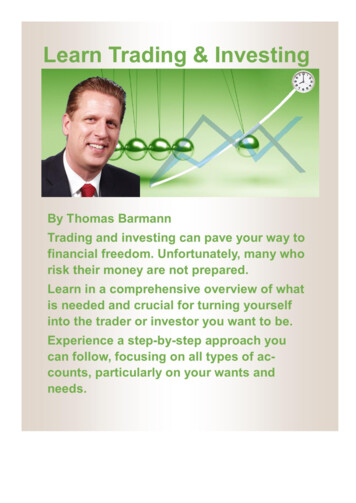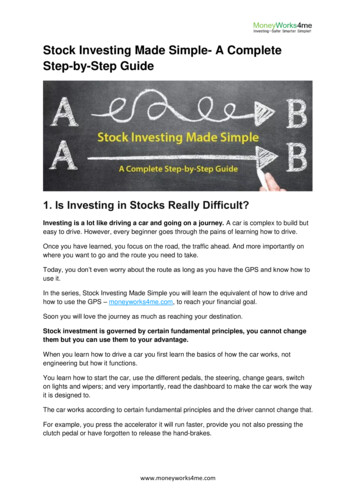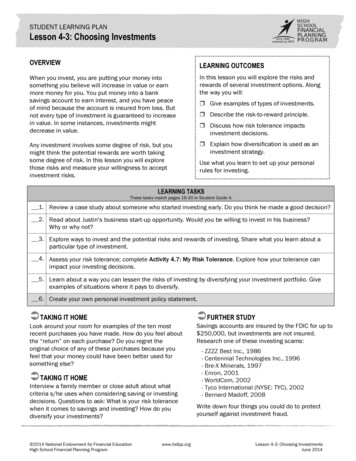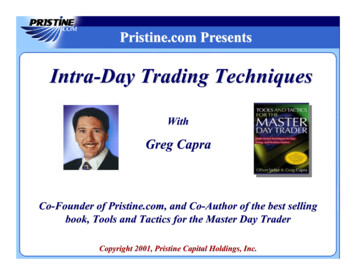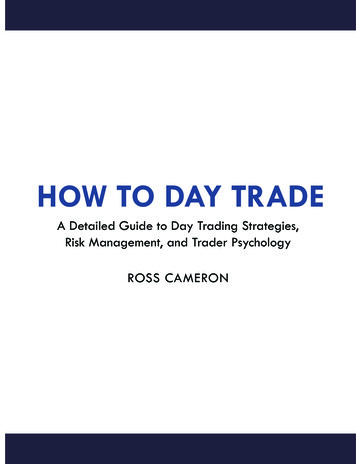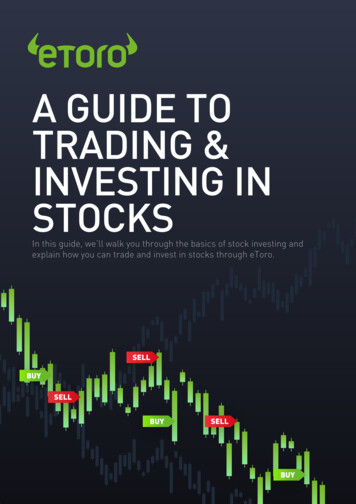
Transcription
A GUIDE TOTRADING &INVESTING INSTOCKSIn this guide, we’ll walk you through the basics of stock investing andexplain how you can trade and invest in stocks through eToro.
INVESTING INSTOCKS CAN BE ONEOF THE MOSTEFFECTIVE WAYS TOGROW YOURWEALTH OVER TIME.While stocks can bevolatile in the shortterm, in the long runthey tend to providemuch higher returnsthan other assets suchas government bondsand cash savings.Interested in learningmore about stocks andhow to invest in them?This guide to trading andinvesting in stocks is agreat place to start. Inthis guide, we’ll walk youthrough the basics ofstock investing andexplain how you caninvest in stocks througheToro.A GUIDE TO TRADING & INVESTING IN STOCKSCONTENTSPG02 What are stocks?PG03 Why invest in stocks?PG05 Investing in stocks vstrading stocksPG06PG08 What drives stockprices?PG09 Developing aninvestment strategyPG10 Stock analysis basicsPGHow to trade stocks on12 eToroPG15 Risks of investing instocksPG17 SummaryPG18 GlossaryHow to profit fromstocksPG 01
WHAT ARE STOCKS?Stocks, or shares as they are often called, are investments that representownership in a company.Companies issue stocks in order to raise money so that they can grow and develop. When you buy a stock, youessentially become a part-owner of the underlying company and are entitled to a share of its profits.Stocks are traded on stock exchanges such as the New York Stock Exchange (NYSE), the NASDAQ, the London StockExchange (LSE), and the Australian Securities Exchange (ASX). A stock exchange acts like a market where buyers ofstocks can connect with sellers. To place a trade, you need an investment account with a stock broker or investmentplatform.At eToro, investing in stocks is a straightforward process. eToro’s platform is easy to use and offers zero commissionsas well as low minimum investments. This means that investing in stocks is something that anyone can do.A GUIDE TO TRADING & INVESTING IN STOCKSPG 02
WHY INVEST IN STOCKS?Investing in stocks can be a great way to grow your wealth over time. Historically,stocks have delivered excellent returns to investors over the long term.For example, since the inception of the S&P 500 index (a stock market index that is composed of 500 large UScompanies) in 1926, it has generated annual returns of around 10% on average. This is a much higher returnthan the returns generated by other assets such as government bonds and cash savings.Price S&P 500 Index Price ChartYearIt’s important to realise that not every stock performs this well. That level of return is an average across allstocks in the index.It’s also important to understand that stocks don’t rise in a straight line. Stock prices can move down as well asup and stocks tend to experience periods of bad performance every now and then.Don’t let this put you off, though. Time and time again, studies have shown that stocks are one of the best longterm investments you can make.A GUIDE TO TRADING & INVESTING IN STOCKSPG 03
FIVE ADVANTAGES OF INVESTING IN STOCKS:Stocks tend to produce high returns over the long termStocks can help you protect your money against inflationStocks are easier to buy and sell than other assets such as real estateYou can start investing in stocks with a relatively small amount of moneyYou can spread your money over many different stocks to lower yourinvestment portfolio riskA GUIDE TO TRADING & INVESTING IN STOCKSPG 04
INVESTING IN STOCKS VS TRADING STOCKSThe terms ‘investing’ and ‘trading’ are often used interchangeably.However, there are key differences between the two financial strategies.Here’s a look at how the two strategies differ.INVESTING IN STOCKSThe goal of investing in stocks is generally tobuild wealth over the long term.TRADING STOCKSThe goal of stock trading is to generate short-term profits.Traders hold stocks for a much shorter period of time thanInvestors will often hold stocks for years, oreven decades, with the aim of generatinginvestors, often buying and selling within weeks, days, oreven hours. Instead of focusing on the company’s long-termsubstantial profits from both rising stockprices and dividends over time.prospects like investors do, traders focus on which directionthe stock is likely to head in next and try to profit from thatInvestors tend to ride out periods ofunderperformance, with the expectation thatstocks will eventually rebound and any shortterm losses will be recovered.move.Traders often use stop-loss orders to automatically closeout losing trades at a predetermined price level in order toprotect their capital.TAKEAWAYBoth investors and traders seek to profit from the stock market, however, they pursue this goal in differentways. Investing is a ‘buy and hold’ long-term strategy, while trading is a ‘buy to sell’ short-term strategy.INVESTINGTRADINGTIMEFRAMEMedium to long termShort termPROFITSFrom rising stock prices and dividendsFrom rising and falling stock pricesINSTRUMENTSStocksStocks or contracts for difference(CFDs)RISKSLimited to initial investmentPotentially magnified by CFD leverageFor more information on the differences between investing and trading, checkout our guide to Investing and Trading.A GUIDE TO TRADING & INVESTING IN STOCKSPG 05
HOW TO PROFIT FROM STOCKSThere are three main ways to make money from stocks.RISING STOCK PRICESThe first way is through increases in stock prices. If you buy a stock and its price rises, you can sell it for aprofit.For example, if you buy one Amazon share when the stock is trading at 2,000 and it rises to 2,200, you cansell it for a 200 profit.This is called generating a capital gain.Price Amazon Price ChartYearDIVIDENDSThe second way you can make money from stocks is through dividends.Dividends are cash payments that some companies pay to their investors out of their profits. Not all companiespay dividends but many well-established companies do.One example of a dividend-paying company is McDonalds. In 2019, it paid its investors a total of 4.73 per share individends.McDonald’s dividend historyDIVIDEND PER SHARE20192018201720162015 4.73 4.19 3.83 3.61 3.44TIP: Dividend payments can often seem insignificant, however, they shouldn’t beignored. Many studies have shown that, over time, dividends tend to make up asignificant proportion of overall stock market returns.A GUIDE TO TRADING & INVESTING IN STOCKSPG 06
FALLING STOCK PRICESFinally, traders can also profit from falling stock prices. This involves using Contracts For Difference(CFDs) to open ‘short’ positions and bet against stock prices rising.CFDs are financial instruments that enable traders and investors to profit from a security’s pricemovements (in both directions) without actually owning the underlying security.If you open a short CFD position on a stock and its share price falls, you can close the trade for a profit.A GUIDE TO TRADING & INVESTING IN STOCKSPG 07
WHAT DRIVES STOCK PRICES?Stock prices are driven by supply and demand.If there are more buyers than sellers of a stock, its price will rise. Conversely, ifthere are more sellers of a stock than buyers, its price will fall.Supply and demand for a stock can be influenced by a number of factors.These include:COMPANY NEWS:Any news surrounding a company will affect demand for its stock. Good news tends to increasedemand, while bad news, or any news that increases uncertainty, tends to decrease demand. Forexample, if a company announces that its quarterly profits are higher than the figure that the marketwas expecting, demand for its stock is likely to rise, pushing its price up. However, if a companyannounces that it is experiencing operational problems and that its quarterly profits will be lower thanthe market was expecting, demand for its stock is likely to fall, pushing its price down.COMPETITOR NEWS:News in relation to a rival company can also impact demand for a stock. For example, if one companyin the automotive sector reports strong annual sales, it may boost demand for other automotive stocks.ANALYST UPGRADES AND DOWNGRADES:Analysts at investment firms such as Goldman Sachs, Citi, and Morgan Stanley regularly provideratings on stocks. These ratings reflect the expected performance of a stock over a given time period.Three common ratings are ‘buy’, ‘hold’, and ‘sell.’ If an analyst upgrades or downgrades a stock, itcan influence demand for the stock. For example, if a major Wall Street firm suddenly upgrades astock from ‘hold’ to ‘buy’, demand for the stock is likely to increase.ECONOMIC AND POLITICAL NEWS:Economic and political developments can also drive demand for a stock. News in relation to interest ratechanges, inflation data, unemployment figures, and political turbulence can all influence investor demand.INVESTOR SENTIMENT:Investor sentiment refers to the overall feeling that investors have about the stock market. This canhave a large impact on supply and demand for stocks. If investors are feeling confident (bullish) thatstocks are likely to rise in the future, demand is likely to be high. However, if investors are concernedabout market conditions and believe that stocks could fall (bearish), demand is likely to decline.A GUIDE TO TRADING & INVESTING IN STOCKSPG 08
DEVELOPING AN INVESTMENT STRATEGYThere are many different approaches to investing in stocks.Some of the main investment strategies that are commonly pursued bystock market investors include:VALUEINVESTING:GROWTHINVESTING:This strategy involves investing inThis strategy involves investingcompanies that are trading at adiscount to their ‘intrinsic’, or truein companies that are expectedto grow at a fast pace in thestock value. The idea is that if astock is trading below its truefuture. Growth stocks can offerhigh potential returns,value, it’s undervalued, and,therefore, may be worth buying.however, they can be volatile,which means that they can beHowever, if a stock is trading aboveits true value, it’s overvalued, and,riskier.QUALITYINVESTING:This strategy involvesinvesting in companies thathave financial strength andare highly profitable. Highquality stocks tend to beresilient and can offerprotection during marketdownturns.therefore, may be worth selling STING:This strategy involves investing insmall companies that have stockThis strategy involves investingin companies that paymarket capitalisations (thecombined value of a company’sconsistent dividends to theirinvestors. Dividend investing istotal shares) of 2 billion or less.Smaller companies tend to producepopular among retirees andthose looking to generatehigher returns than larger, moreestablished companies over time,passive income.SOCIALLYRESPONSIBLEINVESTING (SRI):This strategy involves investingin companies that havefinancial strength and arehighly profitable. High-qualitystocks tend to be resilient andcan offer protection duringmarket downturns.however, they are generally morevolatile.Note that these approaches are not mutually exclusive. Often, investors combine a number ofstrategies. Which strategy is best for you will depend on a number of factors including yourinvestment goals and objectives, financial situation, time horizon, and risk tolerance.A GUIDE TO TRADING & INVESTING IN STOCKSPG 09
STOCK ANALYSIS BASICSBefore you invest in stocks, it’s sensible to do some research.The aim of stock research is to determine which stocks are worth buying andwhich stocks should be avoided.There are two main forms of stock research.The first is what’s known as fundamental analysis.Fundamental analysis involves looking at all available information in relation to a company, including its financialperformance, its financial strength, and the threat of competitors, to determine whether a stock is undervaluedor overvalued.In this form of analysis, investors analyse financial data and often use financial ratios to work out if a stock isworth buying.Three popular ratios used in fundamental analysisRETURN ONEQUITY (ROE):PRICE-TO-EARNINGS(P/E) RATIO:DIVIDENDYIELD:This is the ratio of aThis is the ratio of a company’sThis is the ratio of acompany’s share price to itsdividend per share to its sharecompany’s net income toearnings per share. The P/Eprice. It’s often expressed as athe amount of equityratio is useful because it canpercentage. Dividend yield is(assets minus debt) on itsbe used to compare theuseful because it enables anbalance sheet. ROE is avaluations of different stocks.investor to compare themeasure of how profitabledividends offered by differenta company is.companies.The second form of analysis is known as technical analysis.In this type of analysis, investors examine stock charts and analyse trends, patterns, and indicators in an effortto predict a stock’s future movements. Those who use technical analysis believe that historical pricemovements can be used to predict future price movements.A GUIDE TO TRADING & INVESTING IN STOCKSPG 10
Three popular technical analysis strategiesTRENDTRADING:This strategy aims togenerate profits by analysinga stock’s trend. A trendoccurs when a stock moves inone direction for a long periodof time. Once you haveidentified the trend, it may bepossible to profit from it bytrading in the same directionas the trend.SUPPORT ANDRESISTANCETRADING:This strategy aims togenerate profits by identifyinga stock’s support andresistance levels. Support isthe level on the chart wherethe stock’s price finds itdifficult to fall below.Resistance is the level wherethe stock’s price finds itdifficult to go above. Oncethese areas have beenidentified, it may be possibleto profit by placing trades atthe area where the stock’sprice is likely to reverse.çBREAKOUTTRADING:çThis strategy aims togenerate profits byidentifying stocks that havebroken through establishedsupport or resistance levels.Breakouts can be strongsignals, especially whenconfirmed by other technicalanalysis indicators.Fundamental analysis and technical analysis both have their advantages and disadvantages. For this reason, manyinvestors use a combination of both when making investment decisions.TIP: If you want to learn more about how to trade using technical analysis please visitthe eToro Trading School homepage where you can register for a free courseA GUIDE TO TRADING & INVESTING IN STOCKSPG 11
HOW TO TRADE STOCKS ON ETOROTHERE ARE TWO DIFFERENT WAYS YOU CANTRADE STOCKS ON ETORO:1. You can buy and sell stocks outright (i.e. trade real shares)2. You can trade stock price movements via Contracts For Difference (CFDs). With CFDs, you can trade in bothdirections and also use leverage to increase your exposure.Here’s how to place a trade using each approach:1. BUYING A STOCK OUTRIGHT (NON-LEVERAGED)1. Login or create an account bygoing tohttps://www.etoro.com/#signup2. Head to our Markets page, andthen select Stocks to access thefull list of stocks that areavailable to trade3. Select the stock that you wish toinvest in, then select TradeZ4. Select BUY5. Enter the amount of money youwish to invest in the stock or thenumber of units of stock youwish to buy6. Ensure that leverage is set to X17. Set the take profit parameter ifyou wish to8. Select Open TradeA GUIDE TO TRADING & INVESTING IN STOCKSPG 12
2. TRADING A STOCK VIA A CFD1. Login or create an account by going to https://www.etoro.com/#signup2. Head to our Markets page, and then select Stocks to access the full list of stocksthat are available to tradeZ3. Select the stock that you wish to invest in, then select Trade4. Select BUY or SELL, depending on the direction you wish to trade (BUY if youexpect the stock to rise and SELL if you expect the stock to fall in value)5. Enter the amount of money you wish to trade on the stock or the number of unitsof stock you wish to trade6. Set your leverage (i.e. X2, X5, etc.)7. Set the stop loss and take profit parameters8. Select Open TradeWHAT IS LEVERAGE?Leverage is essentially a loan from yourbroker that enables you to control a largeramount of money than you have depositedfor the trade. For example, leverage of X2means you can trade 200 with a depositof just 100. Leverage is a powerful toolthat can potentially increase your profits.However, it can also increase your lossesso it’s important to understand the risks.It’s also worth noting that CFD positionsthat stay open overnight incur a small fee,relative to the value of the position. This isessentially an interest payment to coverthe cost of the leverage that you useovernight.A GUIDE TO TRADING & INVESTING IN STOCKSPG 13
BUYING THE UNDERLYING ASSET VS TRADING CFDS:WHICH IS THE BEST APPROACH?Both approaches to stock trading offer the potential for fantastic profits.Which approach is better for you will depend on your investing goals and yourrisk tolerance.BUYING THE UNDERLYING ASSET IS GENERALLY SUITED TO THOSE WHO:Plan to hold the stock for an extended period of timeOnly want to profit from upward price movementsAre happy to pay the full value of the trade upfrontDon’t want to use leverage to increase their exposureTRADING VIA CFDS IS GENERALLY SUITED TO THOSE WHO:Want to trade in both directionsHave a lower initial investmentWant to use leverage to increase their exposureAre not concerned about owning the underlying assetA GUIDE TO TRADING & INVESTING IN STOCKSPG 14
RISKS OF INVESTING IN STOCKSAll forms of investing involve some degree of risk and stock investing is nodifferent. It’s important that investors are aware of the risks.Some of the main risks associated with investing in stocks include:STOCKSPECIFIC RISK:This is the risk of a particular stockunderperforming. Every stock has itsown unique set of risk factors and it’simportant to be aware of the risksbefore investing.MARKETRISK:This strategy involves investing incompanies that are trading at a discountto their ‘intrinsic’, or true stock value. Theidea is that if a stock is trading below itstrue value, it’s undervalued, and,therefore, may be worth buying. However,if a stock is trading above its true value,it’s overvalued, and, therefore, may beworth selling or avoiding.LIQUIDITYRISK:This is the risk that you might not beable to sell a stock you own at a fairprice due to a lack of buyers. Liquidityrisk tends to increase during periodsof stock market volatility.LEVERAGERISK:While Leverage Is a powerful tool that canmagnify gains, it can also magnify losses. If alarge amount of leverage is used to trade,even a relatively small price movement in thewrong direction can result in substantiallosses. It’s important to be aware that lossescan exceed the amount invested.A GUIDE TO TRADING & INVESTING IN STOCKSPG 15
RISK MANAGEMENT STRATEGIESYou can never eliminate risk completely when investing in stocks,however, you can reduce it.DIVERSIFY YOUR PORTFOLIOOne of the most effective ways to reduce risk is by diversifying your portfolio. This is theprocess of spreading your money over many different stocks so that you’re not overexposed to any single stock. Owning a diversified portfolio that contains many differentstocks is less risky than owning just one or two stocks.LONG TERM OUTLOOKAdopting a long-term investment horizon is another strategy that can help reduce therisk of losing money. In the short term, stocks can be highly volatile. However, in the longrun, the stock market tends to rise. Generally speaking, the longer you invest for, theless chance you have of losing money.USE STOP LOSSESWhen trading CFDs, stop losses can also be an effective risk management tool. Stoplosses help minimise investing losses by closing out losing positions before large lossesbuild up.ADOPT A BROAD ASSET ALLOCATIONFinally, adopting a broad asset allocation (the mix of different assets in your portfolio) is alsosensible. Wise investors tend to allocate their money across multiple asset classes includingstocks, bonds, commodities, and crypto, as this also helps to reduce overall portfolio risk.A GUIDE TO TRADING & INVESTING IN STOCKSPG 16
SUMMARY:Stocks are investments that represent ownership in a company.Investing in stocks can be a great way to grow your wealth over time. Historically, stockshave delivered excellent returns to investors over the long term.Stock prices are driven by supply and demand. Supply and demand can be influenced by anumber of factors including company news, economic developments, and investorsentiment.There are many different approaches to investing. Some of the main approaches includevalue investing, growth investing, and dividend investing.There are two main forms of stock analysis. Fundamental analysis involves looking at allavailable information to determine whether a stock has profit potential. Technicalanalysis involves looking at chart patterns to determine if a stock is worth buying.Risks of investing in stocks include market risk, stock-specific risk, and liquidity risk.Investing in stocks on eToro is a straightforward process. eToro’s platform is easy to useand offers zero commissions as well as low minimum investments.A GUIDE TO TRADING & INVESTING IN STOCKSPG 17
GLOSSARYCAPITAL GAINCFDCOMMON STOCKDIVERSIFICATIONDIVIDENDSA profit generated from a rising stockContract for difference. A financial instrument that enablesyou to profit from the price movements of securities withoutactually owning the underlying securityShares of ownership in public corporationsSpreading your money out over many different investmentsto lower portfolio riskCash payments that some companies make to shareholdersout of their profitsGOING LONGBuying a securityGOING SHORTSelling a securityINVESTOR SENTIMENTLEVERAGEMARKET CAPITALISATIONMARKET RISKRISKRISK MANAGEMENTThe general mood of investorsUsing capital borrowed from a broker when opening aposition to increase the potential return of an investmentThe total value of a company’s shareThe risk that the whole stock market fallsThe amount of capital exposed on any single tradeFocusing on risk when trading in order to minimise lossesSPREADThe difference between the buy and the sell price. This isalso the cost of placing the tradeSTOCKSInvestments that represent ownership in a companySTOCK EXCHANGESTOCK SPECIFIC RISKSTOP LOSSTAKE PROFITA GUIDE TO TRADING & INVESTING IN STOCKSA market that connects stock buyers with stock sellersThe risks associated with a particular stockAn order designed to minimise lossesAn order to close a trade at a certain profit levelPG 18
eToro is a multi-asset platform which offers both investing in stocks and cryptoassets, as well as trading CFDs.CFDs are complex instruments and come with a high risk of losing money rapidly due to leverage. 75% of retailinvestor accounts lose money when trading CFDs with this provider. You should consider whether youunderstand how CFDs work, and whether you can afford to take the high risk of losing your money.This information is for educational purposes only and should not be taken as investment advice, personalrecommendation, or an offer of, or solicitation to buy or sell, any financial instruments. This material has beenprepared without having regard to any particular investment objectives or financial situation, and has not beenprepared in accordance with the legal and regulatory requirements to promote independent research. Anyreferences to past performance of a financial instrument, index or a packaged investment product are not, andshould not be taken as a reliable indicator of future results. eToro makes no representation and assumes noliability as to the accuracy or completeness of the content of this guide. Make sure you understand the risksinvolved in trading before committing any capital. Never risk more than you are prepared to lose.Guide accurate as of July 2020A GUIDE TO TRADING & INVESTING IN STOCKSPG 19
This guide to trading and investing in stocks is a great place to start. In this guide, we’ll walk you through the basics of stock investing and explain how you can invest in stocks through eToro. A GUIDE TO TRADING & INVESTING IN STOCKS PG 01 PG 02 PG



